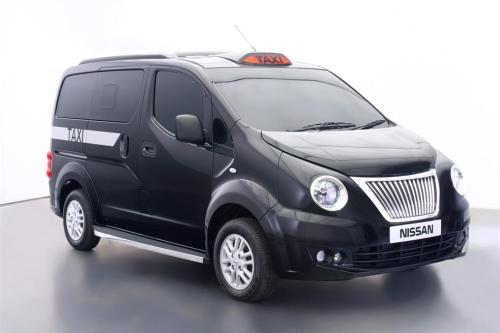Part of me admires Nissan for going after the taxi market in a big way in New York and London.
Another part of me wonders why on earth the London Hackney Carriage solution is so ugly.

I think Nissan should have asked Mr Mitsuoka for advice on how to Anglicize one of its products.
Overall, I haven’t a big problem about a van being a black cab (neither does Mercedes-Benz). We live in the 21st century, and a one-and-a-half-box design makes practical sense. The recent Metrocab, from Frazer-Nash (whose owners are domiciled abroad), doesn’t look perfect, either, but the effect is a bit more cohesive. However, it reminds me a bit of the Chevrolet Spin.
 I’m not sure how conservative a buyer the cabbie is. The LTI TX4 still looks the best, and it is even being adopted in Australia, but it’s not as economical. The idea of the solid axle and Panhard rod at the back doesn’t scream modernity, either.
I’m not sure how conservative a buyer the cabbie is. The LTI TX4 still looks the best, and it is even being adopted in Australia, but it’s not as economical. The idea of the solid axle and Panhard rod at the back doesn’t scream modernity, either.
New Yorkers haven’t really minded the advent of Toyota Siennas and Ford Escapes taking the place of the traditional three-box sedan—nor have the tourists. Therefore, I doubt much romanticism will come in to the decision. As with their counterpart elsewhere, the London cabbie will be very rational and look at the best running costs. That may suggest the demise of the TX4, at least in London. (It seems to have a life of its own in China, although that may depend on how visible it remains in London.)
The world is so globalized that no one bats an eyelid when they see a Volvo badge on a double-decker bus. It’s not that easy to find a police car with a British marque. There’s a nostalgic part of me that wants to argue that the London city brand will be adversely affected by Johnny Foreigner making its cabs, but it won’t. Even the one regarded as traditionally the “most British”, the TX4, is made by a Chinese-owned company, Geely.
History says that it won’t matter. As long as they are black, they can turn on a sixpence, and the cabbie has the Knowledge, then that’ll be sufficient for most. The experience of travelling, rather than the Carriage’s brand, is what tourists will remember—I can’t tell you whether the first black cab I sat in was an FX4 or a TX, but I can tell you about the conversation I had with the cabbie. One would, however, remember a bad journey—let’s say travelling in the back of a Premier Padmini in Mumbai is not as misty-eyed as it seems.
And if one insists on a decent British solution, then it needs to be better than the competition: falling back on tradition (or at least some parody thereof) helped kill Rover when it was still around. Although I’m not sure if there are any British-owned taxi makers left. Whatever the case, the next generation of black cab will be made by a foreign-owned company, and I’m willing to bet that the 20th-century formula is toast.








Taxis around here tend to be Toyota Priuses, if memory serves.
Pardon my ignorance, but what is 3-box and 1-and-a-half box?
Hi J.: if you think about teaching a child how to draw a car, you could teach them that a normal sedan (like a Chevrolet Malibu) has three boxes—hood, passenger compartment, and trunk. A minivan has only a short hood, so that’s half a box, and a passenger compartment, another box, but no trunk, hence one-and-a-half boxes.
Oh, that makes sense. I was thinking you meant something like shape, but didn’t make the art lesson connection.